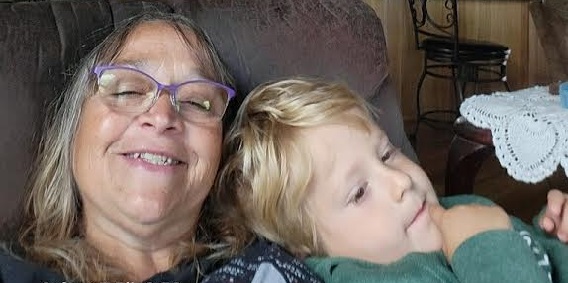Survivor Diagnosed With Mesothelioma and Esophageal Cancer

Fact Checked | Written by: Travis Rodgers | Last Update: 10/24/2024 | 5 Min Read
Tami Pream’s cancer journey began with a strange burning sensation on the left side of her body. At first, she thought it could be an issue with her spleen.
“I had a burning sensation. It was a slight burning sensation. Most people probably wouldn’t have gone to the doctor with it. It was on my left side, and it kept getting worse,” Tami tells us.
Concerned, she went to her doctor who then performed blood work. Her tests indicated her bilirubin levels were high. High bilirubin levels can indicate liver problems, including pressure from cancerous tumors blocking the flow of bile used to digest food from the liver or bile ducts.
These results prompted more testing. A biopsy confirmed she had two different types of cancer. In December 2021, doctors diagnosed Tami with peritoneal mesothelioma and esophageal cancer.
Asbestos is the primary cause of mesothelioma. The link between asbestos exposure is less clear. There are some studies indicating the risk for esophageal cancer is higher in people who were exposed to asbestos. However, more research is needed to see if there’s a possible connection between asbestos and esophageal cancer.
Treating Mesothelioma and Esophageal Cancer
Tami’s doctors recommended treating her esophageal cancer first. She began radiation and chemotherapy in early 2022.
While her doctors didn’t specify which stage she was in at the time of her diagnosis, they did say they caught her mesothelioma early. They told Tami because she listened to her body, the timing of her mesothelioma diagnosis meant cytoreductive surgery was an option for her.
In April 2022, Tami had heated intraperitoneal chemotherapy and cytoreductive surgery. This was soon after she recovered from her esophageal cancer treatment.
She shares with us how her HIPEC procedure was explained to her and what she experienced. “I was on the table for 14 hours,” she notes.
“So what they do is cut you in the middle of your ribs down to your pelvis. Then they went in and took out my spleen, ovaries, gallbladder, and omentum,” Tami explains. “They also scraped several other organs.”
For the HIPEC part of her surgery, she says, “It’s a heated chemo bath. They put a tube in and flush chemo throughout your guts. Flush it for about an hour. Then the doctor removed the tube and sewed me back together.”
Tami’s treatments were successful, and her esophageal cancer is now in remission. However, 2 years later, she’s still dealing with a side effect from her HIPEC treatment.
Complications and Side Effects
“Mayo Clinic did a great job with pain management,” Tami shares. “The worst part of it was the HIPEC treatment compromised my kidneys.”
As a result of the impact on her kidneys, she began kidney dialysis. In total, she underwent 3 dialysis treatments.
“That was pretty scary,” she says. “Since that procedure, I have chronic kidney disease now.”
Because of the complications with Tami’s kidneys, she had to spend twice the amount of time in the hospital to recover: 12-14 days instead of 7 days. Currently, she says she isn’t taking any medication for her kidneys.
“I guess I’m doing a good job of managing it with my diet. My diet has gotten way more complicated,” she notes. “I watch what I eat and drink.”
She explains, “Things like high potassium are definitely not good for your kidneys. So, I try to avoid potassium or reduce my exposure to it.”
Tami says she still experiences severe abdominal pain. She describes it as feeling like muscle cramps.
“It’s like being in labor is exactly how it feels,” she shares. “You don’t know when they will come up.”
She says she’s changed her activities to try to prevent these pain flare-ups. Her ability to sit or stand for long periods has also been affected.
“I will get them more often if I sit on the floor to play with my grandson. So I stopped sitting on the floor,” she adds. “Also, bending over to pull weeds. There are certain things that challenge the stomach muscle that would bring those on.”
In addition to pain, she tells us she’s had other lingering effects as well. “I also have the typical focus issues,” Tami says.
An additional issue Tami faces is a clogged artery. She asked her doctors if the radiation for her esophageal cancer caused the blockage. They told her they can’t confirm this as a possible cause.
This small section of clogged artery is in her heart. Her doctors say it can’t be fixed because it’s so small. She currently takes a few medications for it, but doctors assure her that overall her heart is healthy.
Help During Her Road to Recovery
Throughout Tami’s recovery, she says the one person she could always lean on was her husband, Frank. He was Tami’s primary caregiver during treatment.
“My husband went down with me to the Mayo Clinic and stayed there the whole time going back and forth,” she shares. “He’s been the one caring for me when I needed him and needed something done.”
She says he was also there for her during her recovery, which presented its own challenges. She says recovery can present mental health challenges and she stresses the benefits of staying active and busy with doing the things they really want to do.
“You can have a lot of unhappy days if you sit and think ‘I want to do this’ or ‘I want to do that,’ and you feel like time is running out,” Tami shares. “So get going and do them.”





